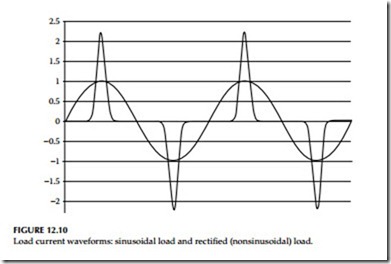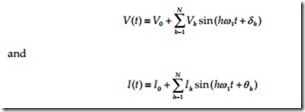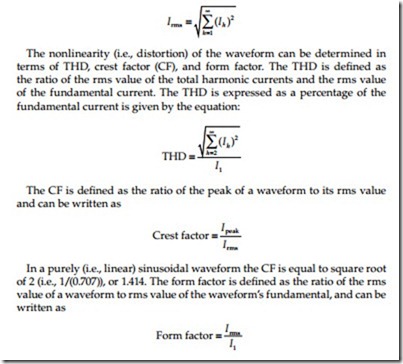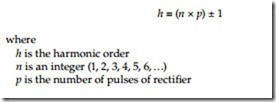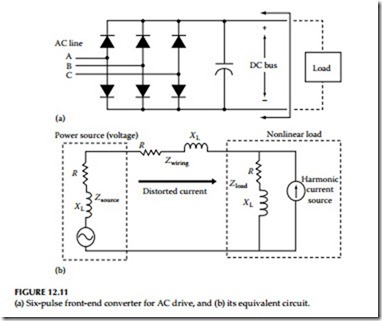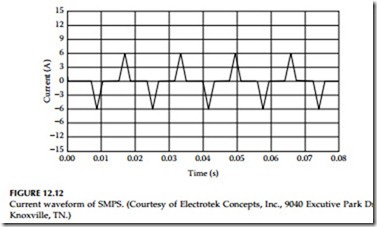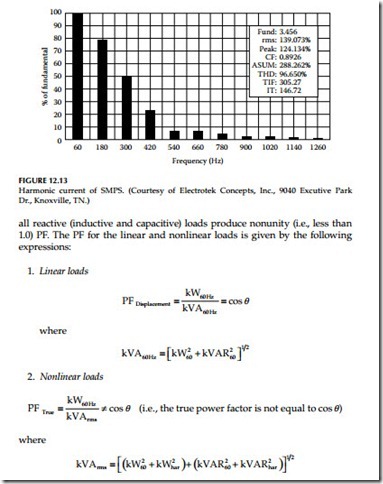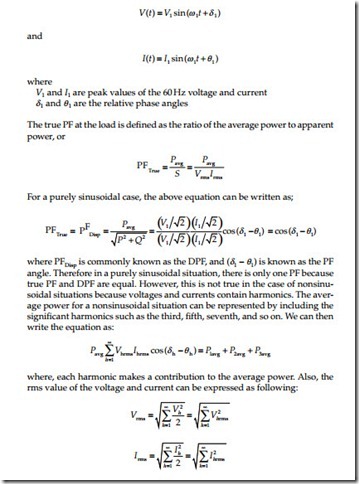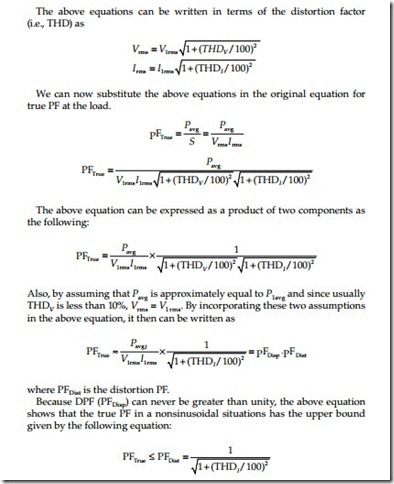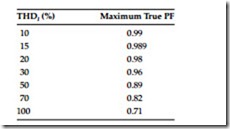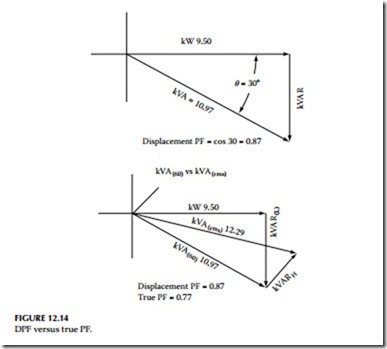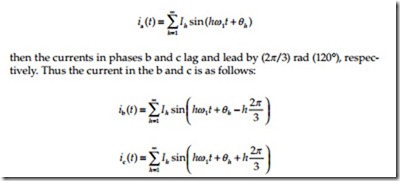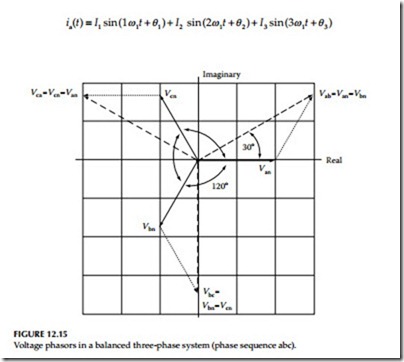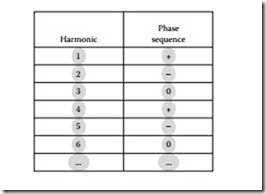Characteristics of Typical Linear and Nonlinear Loads
The harmonic loads may be classified as linear and nonlinear loads. The linear loads that produce harmonics are iron core devices which operate in the nonlinear (saturated) region of the iron core. Also, depending on the winding pitch, motors and generators may produce harmonics. These sources (loads) have been around since the early days of power systems, but the harmonics produced by these devices have been manageable. The traditional (established) sources of harmonics include the following:
• Tooth ripple or ripples in the waveform arising from the rapid pulsations and oscillations of the field flux caused by movement of the poles in front of the projecting armature teeth cause harmonic output. This tooth ripple causes flux distortion in synchronous machines.
• Variations in air gap reluctance over the synchronous machine pole pitch set up a continuous variation in flux, which permeates to the waveshape, and leaves harmonics as a result.
• Flux distortion in the synchronous machine may be due to load effects.
Sharp variations in the load result in sudden changes in machine speed without changes in flux, thus setting up a distorted waveshape.
• Generation of nonsinusoidal emf’s are due to nonsinusoidal distribution of the flux in the air gap of synchronous machines.
• Limited transformer current harmonics, primarily third harmonic, occur at no load.
• Imposition of small and limited amount of nonsinusoidal currents, although input voltages are pure sine wave, occur in networks containing nonlinearity. Typical of these nonlinearities are welders, arc furnaces, voltage controllers, frequency converters, etc.
To a lesser extent, but of importance is the fact that a drastic change in the design philosophy of all power equipment and load equipment has taken place. In the past, manufacturers tended towards underrating or overdesigning most equipment. Now, in order to be competitive, power devices and equipment must be critically designed. In the case of iron core devices, this means that the operating points are more into the nonlinear characteristics, resulting in a sharp rise in harmonics from the established power equipment and load equipment.
Today, however the application of electronic equipment continues to change the electrical environment in the power distribution system of most commercial and industrial facility. In the past, the most common loads found in electrical distribution systems were linear loads such as motors, incandescent lighting, and electric heating. Although these loads still exist in modern facili- ties,otherloads—primarilyelectronic—thathavenonlinearloadcharacteristics represent a large percentage of the total load. Because of the proliferation of nonlinear loads, harmonic currents have increased significantly in electrical distribution systems. Since the electrical distribution systems in most facili- ties were designed to match the characteristics of linear loads (i.e., nearly sinusoidal waveforms), the application of nonlinear loads have caused serious problems such as overheating of conductors, transformers, inadvertent circuit breaker tripping, capacitor failures, and malfunction of electronic equipment. The nonlinear loads consume substantial amounts of energy and thus have a greater impact compared to the linear loads on a facility’s electric power distribution system. Linear loads have an impedance characteristic which is basically constant over time with applied voltage. If a sinusoidal voltage is applied to these loads, the current drawn also is sinusoidal.
In contrast, nonlinear electronic loads do not draw sinusoidal current. The applied power to these loads is either rectified by a diode bridge or the device is turned on and off with switching components such as SCRs, triacs, or transistors. Figure 12.10 shows the current waveforms of linear load (sinusoidal) and recti- fier (SMPS) load. In Figure 12.10, the sine waveform is representative of heaters, incandescent and motor type loads, the pulse waveform is representative of electronic loads that draw current in pulses (i.e., nonsinusoidal waveform), or draw current for the portion of each cycle by turning on and off. The nonsinusoidal loads do not draw current for the entire cycle but rather draw current in
small period per cycle or turn on at a specific point in the cycle. The current drawn by the electronic loads is in abrupt transitions which interact with system impedance causing voltage loss and transients (impulses).
Some electronic loads are constant power loads, such as SMPS, and for these loads a decrease in voltage within the operating range will cause an increase in current to maintain constant power. Also, the harmonic currents of the load interact with the impedance of the distribution system thereby causing harmonic voltage drops. When the distribution system impedance is high, the harmonic voltage drops are high and the harmonic currents for the nonsinusoidal loads are lower. When the distribution system impedance is low, the harmonic voltage drops are low and harmonic current for the non- linear loads are high. The nonlinear loads when combined with high current inrush and high distribution system impedance tend to cause severe voltage dips and voltage waveform distortion. Under these conditions, the constant power electronic loads attempt to compensate by increasing current draw. The increased current draw interacts with the impedance of the distribution system and adds to the voltage dip, and if the voltage dip is severe enough loads throughout the distribution system will crash. In addition to producing line voltage drops, the third harmonic currents (odd-order triplen harmonics) do not cancel out and flow in the neutral circuit of a three-phase, four-wire system. As a result, these currents return back to the power source over the neutral conductor. These currents can be higher than the phase currents and, therefore, create new concerns over the adequacy of the neutral of the three-phase power supply system.
To cope with harmonics problems caused by nonlinear loads, load charac- teristics of system harmonics must be studied and understood. The load characteristics can, for the most part, be determined from an examination of the load response to a distorted voltage waveform at load terminals.
Voltage and Current Characteristics of Nonlinear Loads
HD Terminology
The nonsinusoidal periodic waveform of nonlinear loads can be represented through Fourier analysis as the sum of a DC component and sine waves of various amplitudes and phase displacement from some relative angle. The sine waves all have frequencies which are multiple of the fundamental fre- quency of 60 Hz. The voltage and current waveforms can then be represented as the sum of a DC component and sine waves with a fundamental frequency w1 as follows:
The voltage and current equations represent sine waves that are multiples of a fundamental frequency, and are called harmonics. The effective value (rms) of current waveform where the amplitude of each harmonics is known can be obtained by the equation as follows:
Types of Nonlinear Loads
Four types of nonlinear power electronic devices are increasingly being used in commercial facilities. These are fluorescent lighting, ASDs, SMPS, and uninterruptible power supplies (UPS). A brief description of voltage and current characteristics of each is detailed below.
Fluorescent lighting: Fluorescent lighting has overtaken incandescent lighting as the most popular and widely used lighting system. Light in fluorescent lamps is generated by gas discharge. The lamps require a ballast to provide proper starting and operating voltages and to limit current during lamp operation. Two types of ballasts are used with fluorescent lamps: magnetic core–coil and electronic. Both types generate harmonics. Magnetic ballasts generate third HD typically in the range of 13%–20%. In contrast, recent tests conducted by Lawrence Berkeley Laboratory show that HD generated by currently available electronic ballasts can vary from 5% to well over 33% of the fundamental current, depending on their design. In fact, some types of electronic ballasts generate less harmonic currents than magnetic ballasts. Most manufacturers are holding HD to levels well below those recommended by ANSI (THD less than 32%). In summary, the THD of electronic ballast is comparable to magnetic ballasts, electronic ballast have wide range of individual harmonic currents, and use much less power than magnetic ballasts.
Variable frequency drives (VFDs): Most VFDs contain a front-end rectifier, DC link, and an inverter, operating together with a control system. The recti- fier converts the three-phase AC input to DC voltage. Depending on the type of system, a reactor, a capacitor, or a combination of these are used to smooth the DC signal. The inverter circuit uses the DC voltage to create a variable frequency AC voltage to control the speed of the AC motor. The VFDs are also referred to as ASDs or variable speed drives (VSDs). The characteristic harmonics for a VFD or ASD are based on the number of rectifiers (pulse number) in a circuit and can be determined by the following:
For example, using the above equation, the six-pulse rectifier shown in Figure 12.11a will create characteristic harmonics of 5th, 7th, 11th, 13th, 17th, 19th, and so on. The degree and magnitude of the harmonics is function of the drive design and the interrelationship of the nonlinear load with the connected distribution system impedance. The power source line impedance ahead of the controller will determine the magnitude and amplitude of harmonic currents and voltages reflected back into the distribution system as is shown in Figure 12.11b. The distorted current reflected through the distribution impedance causes a voltage drop or harmonic voltage distortion. This relationship is proportional to the distribution system available fault current and to the distribution system impedance.
The two most commonly used AC drives are: voltage source inverter (VSI) drives and current source inverter (CSI) drives. Each is briefly described below.
VSI drives: VSI drives employ a large capacitor in the DC link to provide a relatively constant voltage to the inverter. The inverter then breaks up this DC voltage to provide the variable frequency AC voltage for the motor. Most inverter drives use pulse width modulation (PWM) techniques to improve the quality of the output voltage waveform. Typical applications of these drives are motors up to 100 hp.
CSI drives: CSI drives are typically used for larger motor applications where custom design can be justified. The DC link consists of a large choke to keep the DC current relatively constant. The inverter then breaks up this current waveform to provide the variable frequency AC signal for the motor. PF characteristics of VFDs also can be very important because the application of capacitors for PF correction can create special problems, including harmonic resonance and transient voltage magnification. The displacement component of the PF is associated with the angle between the voltage and the current. Without any distortion, the PF is equal to the displacement PF (DPF). Both drives have distorted current waveforms, that adds a distortion component to the PF (true PF is real power divided by total apparent power).
The distortion, and therefore the PF, can be considerably worse for VSI-type drives than for most CSI-type drives. Phase-controlled CSI drives have a very poor PF if operated with large rectifier firing delay angles. Transient voltage withstand capability is another important characteristic of VFDs. Power semiconductor switches that have a peak inverse voltage (PIV) rating of only 1200 V are used in many VFDs. On a 480 V distribution system, this PIV rating equates to 177% of normal system voltage. In most power semiconductor switch assemblies, onboard metal-oxide varistors (MOVs) are utilized for protection purposes. While the MOVs are effective for many low energy transients, they can be destroyed by magnified capacitor switching transients if not sized correctly. Drive topology and the control system characteristics also
affect the sensitivity of VFDs to transient disturbances. VSI-type drives require smoothing of the DC line voltage with a large capacitor for proper operation. For protection of inverter components, the DC bus voltage is monitored and the drive is tripped when it exceeds a preset level. Momentary interruptions or voltage dip on the input voltage can affect drive controls as well. This characteristic is very dependent on the specific controls involved, but it is not uncommon for voltage dips lasting only a few cycles to cause drives to trip.
SMPS: SMPS generate harmonics due to the switching action of the recti- fier bridge which supplies the switching regulator. A DC capacitor provides an essentially constant DC voltage for the switching regulator. In order to maintain this DC voltage, the capacitor only needs to draw a pulse of current near the peak on each sine wave. The resulting current waveform is shown in Figure 12.12. The power relationship based on sinusoidal voltage and cur- rents will not be valid with these waveforms. For one thing, the peak current is no longer 1.414 times the rms current. The CF (ratio of peak to rms) for this current is much higher and any meter, controls or relay which is sensitive to the peak current must take this into account. The current drawn by the SMPS contains significant harmonic components. Figure 12.13 shows that the high- est harmonic component is the third.
Harmonic components in this current also have a dramatic effect on the PF of the load. Although the 60 Hz component of the current (fundamental) is in phase with the voltage (DPF close to unity), the harmonic components reduce the true PF and indirectly reduce the real power available.
PF Characteristics of Loads
PF is defined as the ratio of real power divided by the apparent (total) power, i.e., watts divided by volt-amps (VA). Resistive loads produce unity PF, however,
Uncorrected electronic power supplies exhibit very poor true PF and high harmonics which generate heat in the phase and neutral wires of the electrical power distribution system, especially where single-phase 120 V power is supplied from a 208/120 V three-phase wiring system. The PF defines how efficiently a load utilizes the current that it draws from an AC power system. The PF can also be expressed in terms distortion factor to give an assessment of the efficiency of the load utilization in the presence of harmonics. Therefore for a sinusoidal circuit (i.e., no harmonics), we can write voltage and current equations at the load as the following;
The above equation provides insights into the nature of the true PF of electronic (nonlinear) loads, especially single-phase loads. It appears from the above equation that higher the HD, lower is the true PF even though the DPF can be very high. The displacement and true PF relationships are shown in Figure 12.14.
The true PF is calculated for a nonlinear load with distortion (THDI %) as shown below:
The true PFs calculated above represent maximum true PFs for nonlinear loads. Actual true PF is the product of maximum true PF and DPF, and the product can be significantly lower than DPF. The PF comparison shown above gives an optimistic picture because harmonic currents actually cause more losses per ampere than do fundamental currents.
Phase Sequence of Harmonics
Also, similar equations can be written for phase voltages which are shown in Figure 12.15 with b-phase voltage lagging a-phase voltage by 120° and c-phase voltage leading a-phase voltage by 120° (or lagging by 240°).
When the above equations are expanded to include the first three harmonics, we see an important pattern. Thus the above equations for a–b–c phases are
By examining the above current equations, we see that
• The first harmonic (i.e., the fundamental) is positive sequence (a–b–c) because phase b lags phase a by 120°, and phase c leads phase a by 120° (or lags phase a by 240°)
• The second harmonic is negative sequence (a–c–b) because phase b leads phase a by 120°, and phase c lags phase a by 120°
• The third harmonic is zero sequence because all three phases have the same phase angle
If a system is not balanced, then each harmonic can have positive, negative, and zero sequence components. However, in most cases, the pattern shown above can be assumed to be valid.
Because of Kirchhoff’s current law, zero sequence currents cannot flow into a three-wire connection such as a delta transformer winding or a delta-connected load. In most cases, systems are fairly well balanced, so that it is common to make the same assumption for third harmonics and other triplens. Thus, a delta- grounded wye transformer at the service point of an industrial facility usually blocks the flow of triplen harmonic load currents into the power system. Unfortunately, the transformer does nothing to block the flow of any other har- monics, such as fifth, seventh, and so on. Zero sequence currents flow through neutral or grounding paths. Positive and negative sequence currents sum to zero at neutral and grounding points. Another interesting observation can be made about zero sequence harmonics. Line-to-line voltages never have zero sequence components because, according to Kirchhoff’s voltage law, they always sum to zero. For that reason, line-to-line voltages in commercial buildings are missing the third harmonic that dominates L–N voltage waveforms. Thus, the V THD of line-to-line voltages is often considerably less than for L–N voltages.
Harmonic Generating Characteristics
In the past, harmonic currents originated primarily from a few major sources, such as arc welders, fluorescent ballasts and lights, arc furnaces, etc. As explained previously, significant harmonics are being generated by today’s load equipment such as switching power supplies, solid-state controls, and other sensitive electronic equipment. The harmonics in these nonlinear loads cause voltage distortion, poor PF, and stress on supply power system equipment. Harmonics from nonsinusoidal loads interact with electrical distribution system impedance, creating heat in electrical distribution equipment. Harmonic voltage distortion limits peak applied voltage and may increase susceptibility to momentary voltage dropouts.
Sensitivity to Harmonics
Most electronic equipment is affected by harmonics because high levels of harmonic currents cause problems in the power system that is not designed for nonlinear loads. The problems are:
• Overloading of the phase and neutral conductors of the power distribution system
• Overheating of the distribution transformers, where high-frequency currents can cause higher losses from eddy currents, magnetic hysteresis, and skin effect
• Overloading of power sources such as UPS systems and emergency generators including generator controls
• Poor utilization of available power from the branch circuits because of low PF
• Premature failure of PF correction capacitors because of overheating by harmonic currents
• Flat-topping of the voltage waveform caused by high-peak currents which reduce the ride-through capability of the electronic equipment
Sensitivity to Voltage Variation
All electronic equipment is generally sensitive to supply voltage variations. For example, computer systems can experience performance problems if the following voltage thresholds are exceeded: sags greater than −20% rms, spikes greater than 100% peak, and swells greater than +10% rms. When assessing the impact of voltage variation on electronic equipment, it is helpful to know the related voltage waveforms, that is whether they are swell, sag, impulse, or electrical noise. The effects of power line voltage variation, resulting from a utility’s power system disturbances or interaction of the load and its power source, may appear in many forms. Sensitive electronic equipment may cease to operate, errors may occur in processing and data transfer, or hardware damage may occur.
Sensitivity to Voltage Flicker
Voltage changes which are cyclical in nature (occur in the range of 0.5–30 Hz) are commonly referred to as voltage flicker. Voltage flicker can be caused by: repetitive motor starting, punch presses, large reciprocating compressors, resistance welders, and arc furnaces. Voltage flicker can affect the sensitive electronic load equipment, especially if it happens near peak voltage when the DC power supply usually draws AC line current.
Sensitivity to Noise
All power lines, motors, generators, and other current handling devices radiate magnetic fields of varying strengths (electric noise). In addition to the above sources of electrical noise, fault produced transients, surges, and ground potential rises also produce unwanted magnetic fields. The generated and radiated magnetic fields couple across to other cables (both power and communications) and affect sensitive electronic equipment. The level of electrical noise that is considered acceptable depends on the signal level and accuracy requirements of the load equipment. Separation of the electrical noise sources and load signal cables, proper grounding, and proper cable configuration are some of the techniques for reducing noise.
